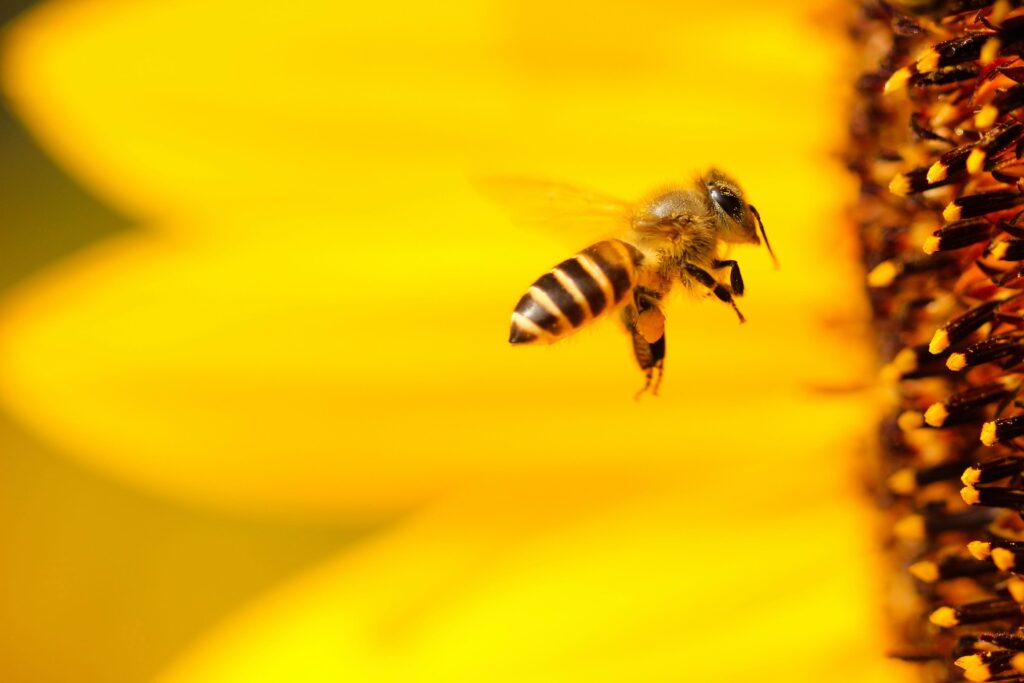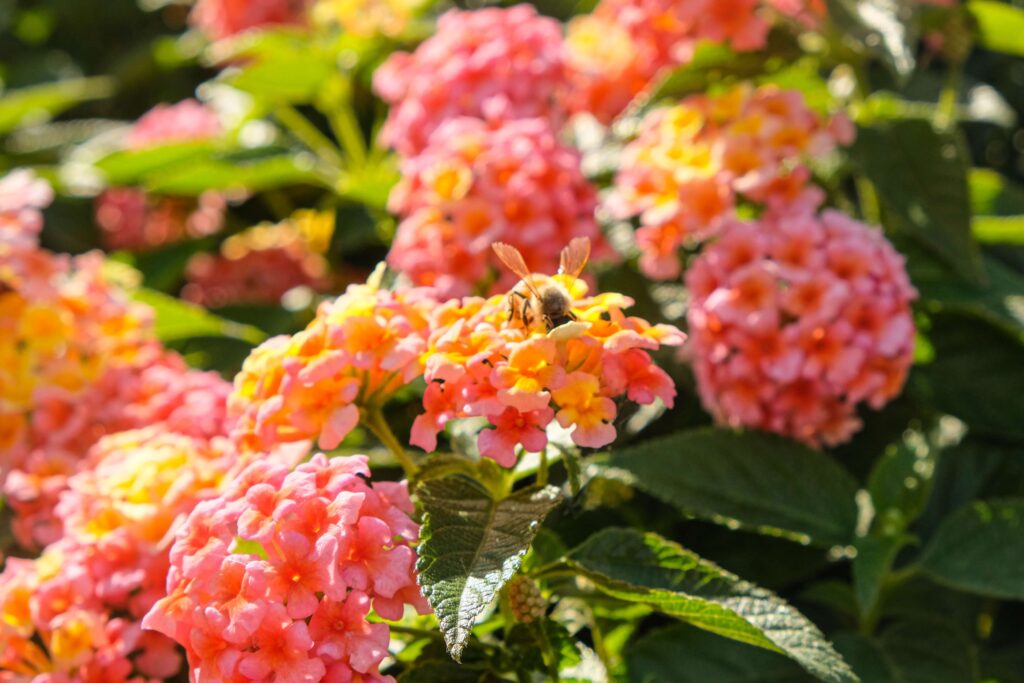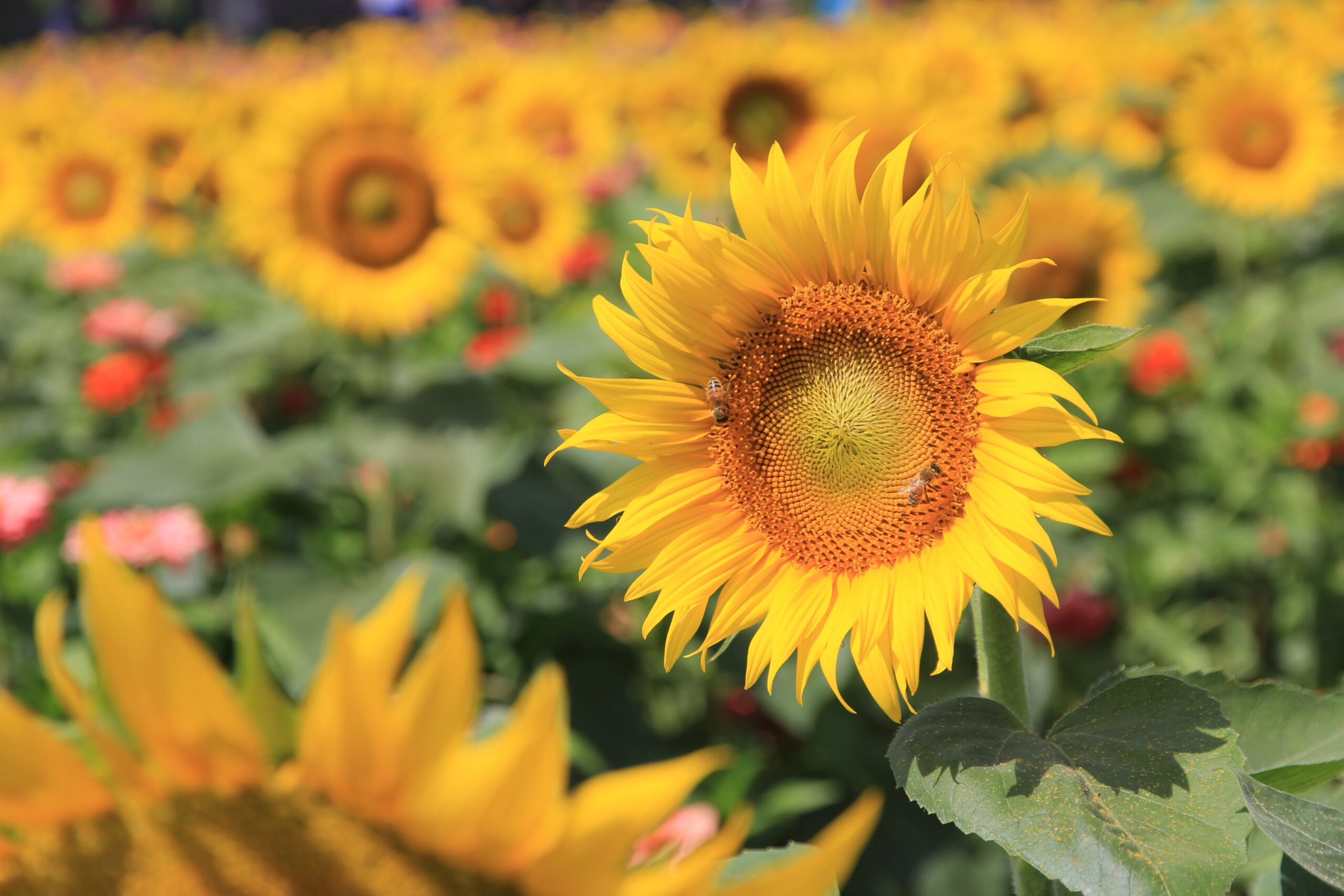It’s time to ditch the boring lawns and lifeless landscapes and start creating vibrant botanical gardens that attract wildlife.
Bee, butterfly, and insect populations are suffering and need our help to survive.
If you have space in your garden or even just an empty spot on a balcony, we’ll show you how to make a pollinator garden that looks beautiful and helps local wildlife thrive.
Table of Contents
What is a Pollinator Garden?

A pollinator garden is a green space that attracts bees, butterflies, birds, and other beneficial creatures that transfer pollen from flower to flower. There aren’t really any rules on what constitutes a pollinator garden; they can be any size and contain almost any plants, as long as they attract beneficial insects and birds.
You might also choose to plant certain species just because you love them personally, even though they’re not known for supporting pollinators. Whether it’s a small balcony or acres of land, a pollinator garden is a great use of outdoor space.
Why Are Pollinator Gardens Important?
Pollinator gardens not only look beautiful, but they also serve an essential purpose. We’ve seen significant drops in pollinator numbers around the world over recent years, so planning your own pollinator garden can help in several key ways.
Essential for food supply

We rely on all types of pollinators for our food supply. Without bees, insects, and some birds cross-pollinating fruits, vegetables, nuts, and most flowering plants, our food supply will drop significantly and leave us in severe food shortages.
Support bee populations
In 2018, we lost around 128,000 bee colonies in the US alone. Numbers are being hit by global warming, pest infestations, destruction of habitat, and a reduction in crops. Bee numbers are still widely at risk, but pollinator gardens can help support local colonies.
How to Make a Pollinator Garden
To make a pollinator garden, choose a location with good soil and full to partial sun exposure. Plant native species and ensure that there is a mix of flowers that bloom in different seasons. Add a water source and avoid using pesticides and herbicides, as these can harm pollinators.
Choose the right location and soil

While many flowering plants can grow in shady and sunny spots, pollinators love to bask in the sun, and some of their favorite wildflowers grow best in full sunlight. If you have a sunny spot in your garden with partial shade, this is a great spot for your new pollinator garden.
As well as location, think about the quality of your soil. Is it sandy and well-draining? Or is it more clay-looking and wet? The soil you have will dictate what kind of flowers will thrive, so do a quick test before you do any planting.
Select native plant species
Visit a local nursery or do some research to find out which species of wildflowers are native to your area. These will grow best and attract the most pollinators to your new garden.
Native plants are always the best choice because they are adapted to your climate and soil conditions. They’ll need much less maintenance and tend to be heartier compared to non-native plants.
You should try to plant a variety of species that bloom through the spring, summer, and early fall. The longer your garden lasts, the more pollinators you’ll be able to support.
Seeds vs. plants
Once you’ve chosen the flowers you want to plant, you’ll have to think about whether to plant seeds or small pollinator plants. Both are good options, and your choice will come down to your timeline and budget.
Established plants are always more expensive, but they’re easier to care for and have a better chance of thriving. Seeds are much cheaper to buy, but they require more time and effort to establish.
If you want to start seeing pollinators in your garden ASAP, go for plants over seeds.
Planting Your Pollinator Garden
When it comes time to plant your new botanical garden, here are a few tips to make sure you get healthy, thriving flowers.
Prep your garden
Whether you’re converting a lawned area into a wildflower meadow or you’ve got a pre-existing flower bed, you’ll need to prepare the soil. Remove any grass or current plant cover and turn the soil to loosen it. You can also add a layer of compost to introduce nutrients into the existing soil.
If you’re going to use containers or raised beds, you’ll need nutrient-rich compost to help give your new flowers all the nutrients they need to grow.
Plant your seeds or flowers
If you’re planting seeds, they need time to germinate, so plant them in the fall to see springtime growth. All you need to do is sprinkle your seeds on the soil and then cover them up with a layer of soil to protect them from the elements.
If you’re starting with plants, follow the guidance given so you don’t plant too early or late in the season. You’ll need to dig a hole large enough for the root system to sit comfortably and then pat fresh soil down around the top to keep it upright.
A thin layer of mulch can also be useful to reduce weeds and keep the soil moist.
Wait, watch, water & weed
Once your plants are in, it’s time for the four Ws: wait, watch, water, and weed. Keep the soil moist while the plants are young, but don’t let the roots get water-logged. It can take a season or two before you start seeing large blooms, so be patient.
The 12 Best Plants for a Pollinator Garden

Remember, native species are always best when it comes to making a pollinator garden, but here are a few of the best options to help you choose.
Bee balm
Monarda – also known as bee balm – is a perennial flower that attracts many essential pollinators, including bees and hummingbirds. It’s known for its sweet nectar and fanciful blooms that stay prominent well into July.
Black-eyed Susan
This is coneflower, just like Echinacea and Helenium. They have pretty, sunny faces that quickly attract bees and butterflies. Our favorite type is the “Prarie Sun” variety which has an interesting pale-green center.
Butterfly weed
Although it’s got “weed” right there in the name, the butterfly weed is a helpful plant that pollinators adore. It’s a type of milkweed that plays an essential role in the life cycle of monarch butterflies, so expect to see plenty of these fluttering around your garden.
Coneflower
Echinacea is truly irresistible to butterflies and bees, drawn in by the sweet nectar and cone-shaped flower heads. Birds also love this variety, so you’ll likely see small birds around feeding on the seeds.
Goldenrod
The goldenrod is a late-season pollinator plant that honey bees look for. Prior to winter, honey bees collect large amounts of nectar from this flower as a provision for late-season nests. Even when most other flowers have died back for the winter, goldenrods will stand strong, so they’re a great addition to any pollinator garden.
Joe-Pye weed
This one is a tall, perennial plant that’s known for its ability to attract butterflies. It’s named after the famous herbalist Joe Pye, who used the plant to treat fevers. The Joe–Pye weed blooms from late summer to early fall, when many other species have stopped flowering, so it’s great to help support bees.
Milkweed
Milkweed is a hardy plant that does well in most types of soil. Butterflies, bees, beetles, moths, and even wasps love the nectar from milkweed plants, so you’ll get lots of buzz in your new pollinator garden with this flower.
Penstemon
The penstemon blooms for six months out of the year; it’s slug resistant and very easy to grow. If you want some low-maintenance flowers for your pollinator garden, this is your best bet. The bell-shaped flowers attract bees, and they can rely on this plant for half of the year.
Phlox
The beautiful scent of the phlox is enough reason to add it to your garden. It grows in clouds, quickly enticing bees and butterflies, and the huge flower heads look stunning throughout the summer.
Salvia
The nectar-rich flowers of the salvia attract a wide range of pollinators, including honey bees, native bees, butterflies, and even hummingbirds. Part of the sage family, it has an earthy aroma and tall, thin blooms.
Sunflower
What pollinator plant list would be complete without the sunflower? The large, bright blooms are a firm favorite with kids and pollinators alike, and they’re great fun to grow. The common sunflower and the cucumber leaf sunflower are both recommended by the Royal Horticultural Society as great for pollinators.
Verbena
For a low-maintenance cottage vibe, the Verbena is a great choice. It has long spires of purple blooms that are loved by bees and butterflies, which will happily bloom through the summer and autumn with little pruning.
Zinnia
Last but not least, the zinnia is loved by bees. Although bees can’t see its red hue, they are attracted to the ultraviolet markings in the petals and the sweet nectar hidden within tufty layers of petals.
Pollinator Garden FAQs
Q: What is the best location for a pollinator garden?
A: The best location for a pollinator garden is an area that receives full sun or partial shade and is sheltered from strong winds. The garden should also have a water source readily available for pollinators.
Q: How do you pollinate a garden?
A: Pollination of a garden can be done naturally by attracting bees, butterflies, and other pollinators with the use of specific plants, providing a water source, and avoiding the use of pesticides that may harm pollinators. Alternatively, pollination can be done manually by transferring pollen from one plant to another using a small brush or cotton swab.
Final Thoughts
If you have the space, a pollinator garden is a wonderful addition to any home. The bright, vibrant flowers look stunning throughout the summer, and it’s wonderful to see bees, butterflies, and hummingbirds enjoying the fruits of your labor.
When it comes to the question of how to make a pollinator garden, just remember to go for native flowers for the best results. Ask for help from a local nursery if you’re struggling to choose the best local plants for your new pollinator garden.

